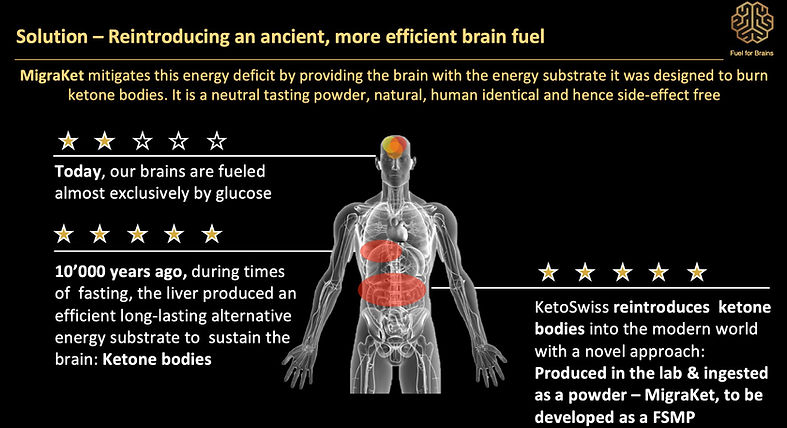

Scientific Background
Ketone bodies: The forgotten alternative brain fuel
Today, due to our carbohydrate-rich diets, our brains are fuelled almost exclusively by glucose. However, 10,000 years ago, during times of fasting when carbohydrates were not available, the body produced an efficient long-lasting alternative energy substrate when glucose was not available: ketone bodies (Fig 1). In practice, the human brain has been engineered to burn ketone bodies whenever available. The brain prefers ketone bodies over glucose when given the choice and babies are born producing ketone bodies.
Figure 1: Ketone bodies - an ancient brain fuel.

Potential causes of migraine
Recent research suggest that migraine is is associated with energy metabolic impairment of the brain.[1],[2] Our recent Nature Neurology Review on the Metabolic Face of Migraine shows cerebral metabolomics that might be involved in migraine pathogenesis and therapeutic targets. In Fig. 2 glucose crosses the blood–brain barrier via insulin- independent glucose transporter 1 (GLUT1) (step 1), deficiency of which can contribute to migraine, as can insufficient glucose, oxygen, water or minerals. GLUT1 is expressed by capillary endothelial cells and astrocytes. Non- oxidative glucose metabolism produces pyruvate (step 2), which is converted to lactate and shuttled to neurons through monocarboxylate transporters (MCTs; mainly MCT1 and MCT4 in astrocytes and MCT2 in neurons). In neurons, this lactate can be used as an energy substrate following its conversion to pyruvate, which can be converted into acetyl- coenzyme A (Acetyl- CoA) and fed in turn into the tricarboxylic acid cycle (TCA) (step 3). Neurons can also take up glucose via neuronal GLUT3 (step 4), which is insulin- dependent and can be influenced by insulin resistance.
[1] Cevoli, S., Favoni, V., & Cortelli, P. (2019). Energy metabolism impairment in migraine. Current medicinal chemistry.
[2] Gross, E.C., Lisicki, M., Fischer, D., Sandor, P.S. & Schoenen, J. (2019). The Metabolic Face of Migraine. Nature Reviews Neurology.
Ketone bodies (β- hydroxybutyrate (BHB) and acetoacetate (AcAc)) cross the blood–brain barrier via MCT1 transporters (step 5) and penetrate astrocytes via MCT1 or MCT4 (step 6) and neurons via MCT2 (step 7). BHB provides an alternative to glucose as a substrate for oxidative phosphorylation; it is converted to AcAc and, subsequently, acetyl- CoA, which enters the TCA to produce ATP (step 8). BHB also has antioxidant properties and, compared with glucose, its conversion to ATP produces fewer reactive oxygen species (ROS) per oxygen molecule consumed. Increased ROS, nitric oxide, lack of energy substrates or lack of necessary co- enzymes inhibit mitochondrial function and reduce ATP levels (step 9). Antioxidants and co- enzymes, such as riboflavin, other B vitamins, coenzyme Q10 (CoQ10), magnesium, α- lipoic acid (AL A), l- carnitine and the anticonvulsant topiramate, support mitochondrial function and protect against migraine. AQP4, aquaporin 4; ETC, electron transport chain.
Figure 2: Cerebral metabolomics that might be involved in migraine pathogenesis and therapeutic targets
The potential migraine protective mechanisms of ketone bodies
Research suggest that amongst key migraine pathophysiological mechanisms are hypometabolism, decreased glucose transport (including glucose transporter 1 (GLUT1) deficiency), reduced mitochondrial functioning, increased cerebral excitability, increased cortical spreading depressions (CSD) incidence, increased oxidative stress (reactive oxygen species (ROS)), increased inflammation, microbiome abnormalities and reduced digestive health.
D-β-hydroxybutyrate (D-BHB; with or without the context of a ketogenic diet) has been shown to positively influence each of these mechanisms (Fig. 3): increasing cerebral metabolism, increasing glucose transport (including glucose transporter 1 (GLUT1) deficiency), increasing mitochondrial functioning, reducing cerebral excitability, decreasing cortical spreading depressions (CSD) incidence, reducing oxidative stress (reactive oxygen species (ROS)), decreasing inflammation, improving the microbiome and increasing digestive health.

Potentially migraine relevant mechanisms of ketosis

Figure 3: Potentially migraine protective mechansims of ketone bodies.
ATP = adenosine triphosphate; CSD = cortical spreading depressions; D-BHB = D-β-hydroxybutyrate; GLUT1 = glucose transporter 1; ROS = reactive oxygen species
Publications
Gross, E. et al. Efficacy and safety of exogenous ketone bodies for preventive treatment of migraine: A study protocol for a single-centred, randomised, placebo-controlled, double-blind crossover trial. Trials 20, 61 (2019).
Gross, E. & Fischer, D. Migraine Prevention and Treatment. (2018). Patent WO 2018/115158 A1.
Gross, E. C., Klement, R. J., Schoenen, J., D’Agostino, D. P. & Fischer, D. Potential Protective Mechanisms of Ketone Bodies in Migraine Prevention. Nutrients 11, (2019).
Gross, E. C., Lisicki, M., Fischer, D., Sandor, P. S. & Schoenen, J. The Metabilic Face of Migraine. Nature Neurology (2019).
.png)







